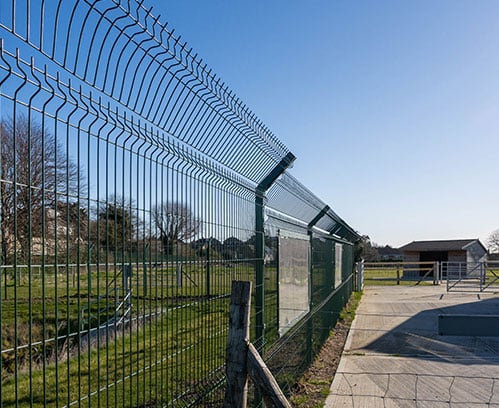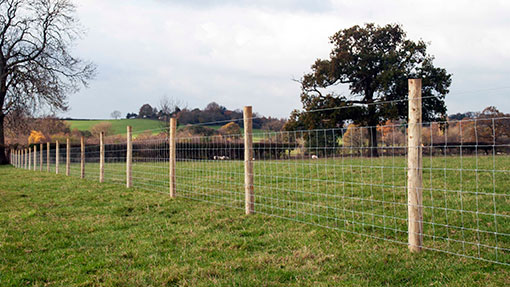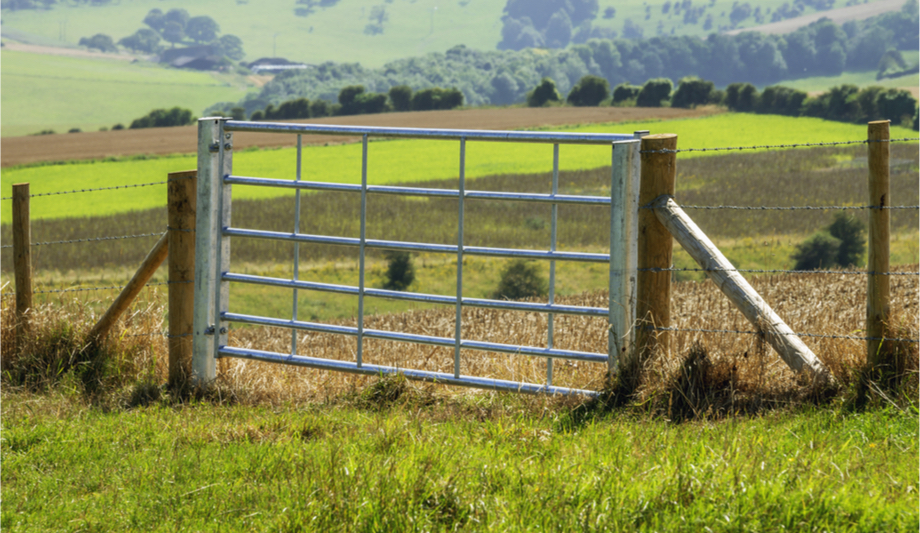Are you looking to secure your farm and protect your livestock? Wondering how to choose the right fencing for your needs? Well, in this article, we’ll delve into the topic of livestock fencing and explore all the different aspects you need to consider. By the end, you’ll have a better understanding of the options available to you and be able to make an informed decision. So keep reading to find out more!
Livestock fencing is an essential component of any farm or ranch. It not only helps to keep your animals safe and secure but also plays a crucial role in managing your land effectively. From traditional options like wooden and wire fences to modern alternatives like electric and mesh fences, there’s a wide range of choices to suit your specific requirements. In this article, we’ll discuss the pros and cons of different types of livestock fencing, factors to consider when choosing a fence, and tips for installation and maintenance. So whether you have cattle, horses, sheep, or other livestock, we’ve got you covered. Stay tuned for valuable insights and expert advice that will help you secure your farm with the right livestock fencing.
Secure Your Farm with Livestock Fencing

Different Types of Livestock Fencing
Livestock fencing plays a crucial role in protecting and managing your farm animals. It ensures their safety, prevents escape, and maintains biosecurity. There are several types of livestock fencing available, each with its own advantages and considerations.
Wooden Fencing
Wooden fencing is a traditional and aesthetically pleasing option. It offers a strong physical barrier and can be customized to fit different farm landscapes. However, wooden fencing requires regular maintenance, such as painting or staining to prevent rot and termites. It can also be expensive to install and repair.
Wire Fencing
Wire fencing is a popular choice for livestock, thanks to its versatility and affordability. It can be made of various materials, such as galvanized steel or high-tensile wire. Wire fencing is durable and can withstand pressure from large animals. It is also easy to install and maintain.
Electric Fencing
Electric fencing is an effective option for containing and managing livestock. It uses electric shocks as a deterrent to keep animals within the desired boundaries. Electric fencing is low-cost, easily adjustable, and can be easily moved to different locations. However, it requires consistent power supply and regular maintenance to ensure proper functioning.
Barbed Wire Fencing
Barbed wire fencing is primarily used for containing cattle. It consists of sharp, barbed wires that act as a physical barrier. Barbed wire fencing is relatively affordable, easy to install, and provides a high level of security. However, it may not be suitable for all types of livestock due to the risk of injury. It also requires regular checks and maintenance to prevent sagging or tangling.
Factors to Consider Before Choosing Livestock Fencing
Selecting the right type of livestock fencing involves careful consideration of various factors. By taking these into account, you can ensure that your chosen fencing meets your specific needs and requirements.
Budget and Cost
The budget allocated for livestock fencing is an important factor. Different types of fencing have varying costs, including installation and maintenance expenses. It’s essential to determine how much you are willing to spend to secure your farm effectively.
Durability and Longevity
Livestock fencing should be durable and able to withstand various environmental conditions. Factors such as weather, livestock behavior, and potential external pressures should be considered when assessing the durability of different fencing materials.
Animal Safety and Containment
The primary purpose of livestock fencing is to ensure the safety and containment of animals. Depending on the type and size of your livestock, you might need specific features, such as smaller gaps between wires or taller fence heights, to prevent escapes and injuries.
Maintenance Requirements
Different types of livestock fencing have varying maintenance requirements. Some may require regular cleaning, painting, or repairs. Understanding the maintenance needs of each type of fencing helps you estimate the time and effort required to keep your fence in good condition.

Importance of Proper Livestock Fencing
Having proper livestock fencing is crucial for the overall management and security of your farm. It serves several important purposes beyond just keeping your animals in.
Preventing Animal Escape
One of the primary functions of livestock fencing is to prevent animals from escaping their designated areas. Properly installed and maintained fencing ensures that your animals remain within their intended boundaries, reducing the risk of injuries, loss, or damage.
Protecting Livestock from Predators
Livestock fencing acts as a deterrent for predators, such as coyotes, wolves, or bears, keeping them at bay and protecting your animals. By securing your farm with sturdy fencing, you can minimize the chances of predation and keep your livestock safe.
Securing Farm Boundaries
Livestock fencing clearly defines your farm’s boundaries, preventing encroachments and disputes with neighboring properties. Clearly marked boundaries promote good neighborly relations and prevent unnecessary conflicts.
Minimizing Property Damage
Livestock fencing helps minimize property damage by keeping animals away from sensitive areas, such as gardens, crops, or infrastructure. By confining animals to designated spaces, you can protect your property from unnecessary destruction.
Maintaining Biosecurity
Properly constructed livestock fencing helps maintain biosecurity by preventing the entry of unwanted animals and minimizing the risk of disease transmission. By controlling and restricting access to your farm, you can protect your livestock from potential health hazards.
Installation and Maintenance of Livestock Fencing
Installing and maintaining your livestock fencing correctly is crucial for its effectiveness and longevity. Here are the key steps to consider:
Choosing the Right Materials
Selecting the appropriate fencing materials based on your specific needs and budget is vital. Consider factors such as durability, animal type, terrain, and maintenance requirements when choosing materials.
Proper Fence Height and Spacing
The height and spacing of your livestock fencing should be appropriate for the type of animals you are keeping. Taller fences and narrower wire spacing may be necessary for larger or more agile animals, while smaller gaps can work for smaller livestock.
Digging Post Holes and Setting Posts
Properly digging post holes and setting posts at the correct depth is essential for the stability and structural integrity of your fence. Consult local regulations and guidelines to determine the suitable depth for your specific fencing type.
Attaching and Stretching Fence Wire
Attaching and stretching fence wire securely ensures a strong and effective barrier. Follow manufacturer instructions for proper attachment methods and use tensioning tools to achieve the desired level of tightness.
Regular Inspections and Repairs
Regularly inspecting your livestock fencing and addressing any damage or wear helps maintain its effectiveness. Repairing or replacing broken wires, damaged posts, or sagging sections ensures the continued security of your farm.

Common Mistakes to Avoid in Livestock Fencing
To ensure the success of your livestock fencing, it’s important to avoid common mistakes that can compromise its integrity and functionality.
Using Inadequate or Low-Quality Materials
Opting for inferior materials to cut costs can lead to early deterioration and compromised security. Investing in high-quality, durable materials helps ensure the longevity and effectiveness of your livestock fencing.
Incorrectly Spacing Fence Posts
Improper spacing between fence posts can result in weakened sections and potential sagging or collapsing. Following industry recommendations for spacing ensures structural stability and overall efficiency.
Neglecting Regular Maintenance
Failing to inspect and maintain your livestock fencing regularly can lead to small issues escalating into larger problems. Regularly check your fence for damage, wear, or potential hazards, and address any issues promptly.
Improper Grounding of Electric Fencing
For electric fencing, proper grounding is essential to ensure the electric shock effectively deters animals. Follow manufacturer guidelines for grounding, including using appropriate grounding rods and connections.
Addressing Specific Livestock Fencing Needs
Different types of livestock have diverse fencing requirements. Understanding these specific needs enables you to choose the most suitable fencing options.
Cattle Fencing
Cattle fencing should be sturdy and capable of containing large, powerful animals. High-tensile wire or barbed wire fencing is commonly used for cattle, with proper heights and secure attachment.
Horse Fencing
Horse fencing should focus on both containment and the prevention of injuries. Smooth wire, woven wire, or electric tape fencing with appropriate heights and minimal wire spacing are common choices for horse enclosures.
Sheep and Goat Fencing
Sheep and goat fencing often requires smaller gaps between wires to prevent escapes. Woven wire or electric fencing with smaller meshes is commonly used to keep small livestock contained.
Poultry Fencing
Poultry fencing should protect birds from predators while allowing them access to grazing areas. Chicken wire or electric netting with appropriate heights and secure anchoring is commonly used for poultry enclosures.

Enhancing Livestock Fencing for Extra Security
In addition to selecting the right type of livestock fencing, there are several measures you can take to enhance the security of your farm.
Adding Gates and Access Points
Install sturdy gates and access points that are easily controlled and securely closed. Adding locks or automated gate systems can further enhance security and prevent unauthorized access.
Installing Security Cameras
Installing security cameras around your farm can help monitor your livestock and identify any potential threats or suspicious activities. Choose cameras with night vision capabilities for round-the-clock surveillance.
Implementing Intruder Detection Systems
Intruder detection systems, such as motion sensors or alarms, can provide an additional layer of security. These systems can alert you to any unauthorized entry attempts or unusual activity near your livestock fencing.
Dealing with Challenging Terrain in Livestock Fencing
Navigating challenging terrain requires careful planning and considerations to ensure the effectiveness and stability of your livestock fencing.
Fencing on Slopes or Uneven Ground
When fencing on slopes or uneven ground, consider the contours and adjust the fence line accordingly. Contoured fences or step-down fences help maintain consistent fence height while accommodating changes in terrain.
Fencing Near Water Sources
Fencing near water sources requires special attention to prevent erosion or damage. Use materials that can withstand water exposure, such as galvanized steel, and consider adding additional reinforcements or barriers where needed.
Fencing in Rocky Terrain
Fencing in rocky terrain may require specialized tools or equipment for digging post holes. Consider using alternative methods, such as rock drilling or anchor systems, to securely install posts in rocky areas.

Legal Considerations for Livestock Fencing
Before installing livestock fencing, it’s essential to understand the legal considerations and regulations that may apply to your area.
Fencing Laws and Regulations
Research local laws and regulations regarding livestock fencing, including any height, materials, or setback requirements. Complying with these regulations helps ensure you are within the legal boundaries and prevent potential penalties.
Boundary Disputes and Neighbor Relations
Maintaining positive neighbor relations and addressing any boundary disputes or concerns is crucial. Clearly defining your property boundaries and communicating with neighboring landowners can help prevent conflicts related to livestock fencing.
Evaluating Livestock Fencing Contractors
If you’re considering hiring a contractor to install or repair your livestock fencing, it’s important to evaluate their credentials and experience.
Checking Credentials and Experience
Research the contractor’s credentials, including licenses, certifications, and any relevant experience in livestock fencing. Look for contractors with a proven track record of successful projects and positive customer feedback.
Requesting Quotes and Estimates
Ask for detailed quotes and estimates from potential contractors, clearly outlining the scope of work and associated costs. Compare these quotes to ensure you are receiving fair pricing and a comprehensive service package.
Reading Customer Reviews
Read customer reviews and testimonials to gain insights into the contractor’s reliability, workmanship, and overall customer satisfaction. This can help you make an informed decision when choosing a livestock fencing contractor.
Reviewing Past Projects
Ask the contractor for references or examples of their past livestock fencing projects. Visiting these sites or reviewing photographs can give you an idea of their work quality and attention to detail.
Innovations and Trends in Livestock Fencing
The field of livestock fencing continues to evolve, with several innovations and trends that offer enhanced security and convenience.
Smart Fencing Technology
Smart fencing technology integrates sensors, GPS, and wireless connectivity to provide real-time monitoring and control of livestock fencing. It can send alerts for breaches, track animal movement, and enable remote access to fence settings.
Solar-Powered Electric Fencing
Solar-powered electric fencing utilizes renewable energy for electrical charges, making it more environmentally friendly and cost-effective. It eliminates the need for constant power supply and reduces the overall carbon footprint.
Eco-Friendly Fencing Materials
The use of eco-friendly fencing materials, such as recycled plastics or sustainable timber, minimizes the impact on the environment. These materials offer durability and functionality while reducing the reliance on non-renewable resources.
Benefits of Professional Livestock Fencing Installation
Engaging a professional livestock fencing installation service offers several advantages over a DIY approach.
Expertise and Experience
Professional installers possess the necessary expertise and experience to design and install livestock fencing tailored to your specific requirements. They can address challenges, offer expert advice, and ensure optimal results.
Time and Effort Savings
Hiring professionals to install your livestock fencing saves you time and effort. They handle all aspects of the installation process, including material sourcing, acquiring permits, and ensuring compliance with local regulations.
Long-Term Cost Efficiency
Professional installation ensures that your livestock fencing is correctly installed and structurally sound, minimizing the need for future repairs or replacements. This can result in long-term cost savings.
Quality and Warranty Assurance
Reputable installers often provide warranties for their work, giving you peace of mind knowing that any issues or defects will be addressed. Their commitment to quality ensures that you receive a secure and reliable livestock fencing system.
Commonly Asked Questions about Livestock Fencing
To address common questions and concerns, here are some frequently asked questions about livestock fencing:
How high should livestock fencing be?
The appropriate fence height depends on the type and size of the livestock you are containing. For larger animals like cattle or horses, a fence height of at least 5 to 6 feet is recommended. Smaller animals may require lower fence heights.
Can electric fencing harm animals?
Electric fencing delivers a mild electric shock that startles and discourages animals from crossing. It rarely causes harm or injury if properly installed and used according to the manufacturer’s guidelines.
What is the best fence for cattle?
High-tensile wire or barbed wire fencing is commonly used for cattle due to their strength and durability. These types of fencing offer a high level of security and containment for cattle.
How to keep predators away from livestock?
In addition to secure fencing, additional measures can be taken to deter predators, such as using motion-activated lights or sound devices, installing predator-proof enclosures, or keeping livestock guardian animals like dogs or llamas.
Conclusion
Investing in proper livestock fencing is crucial for ensuring the safety, containment, and overall management of your farm animals. By considering the various types of livestock fencing, evaluating important factors, and understanding the importance of expert installation and maintenance, you can secure your farm effectively. Remember to address specific livestock needs, enhance security measures, and comply with legal considerations. With the right approach and attention to detail, you can create a secure environment for your livestock and protect your farm for years to come.
Related Articles:
- The Pros and Cons of Different Types of Livestock Fencing
- Essential Tools and Equipment for Livestock Fence Installation
- How to Choose the Right Livestock Fencing Contractor
- The Role of Livestock Fencing in Sustainable Farming Practices
- Protecting Livestock from Disasters: Emergency Preparedness and Fencing Solutions
For more articles and information on livestock fencing, visit Fence Dude.